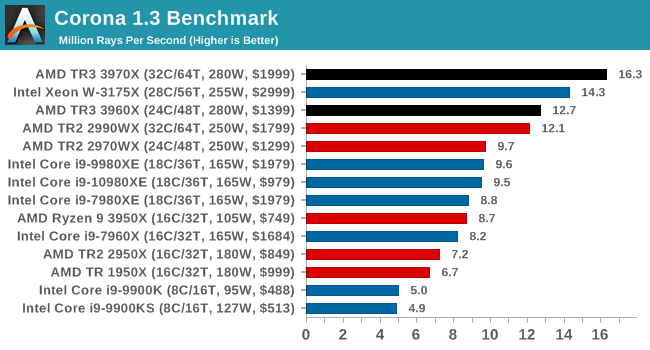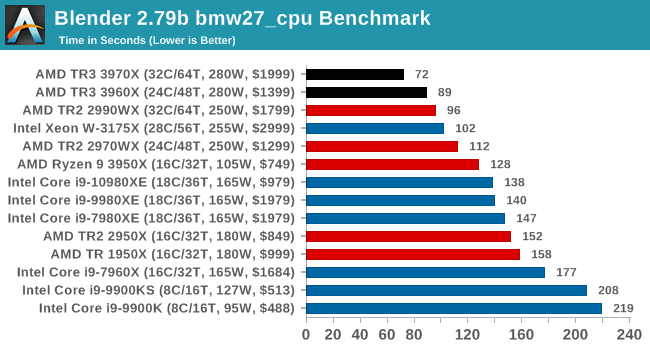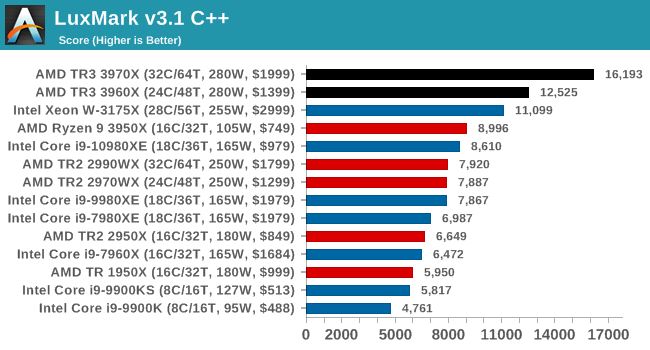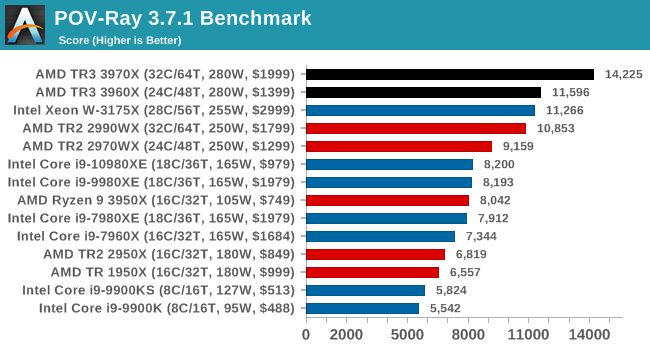The AMD Ryzen Threadripper 3960X and 3970X Review: 24 and 32 Cores on 7nm
by Dr. Ian Cutress, Andrei Frumusanu & Gavin Bonshor on November 25, 2019 9:05 AM ESTCPU Performance: Rendering Tests
Rendering is often a key target for processor workloads, lending itself to a professional environment. It comes in different formats as well, from 3D rendering through rasterization, such as games, or by ray tracing, and invokes the ability of the software to manage meshes, textures, collisions, aliasing, physics (in animations), and discarding unnecessary work. Most renderers offer CPU code paths, while a few use GPUs and select environments use FPGAs or dedicated ASICs. For big studios however, CPUs are still the hardware of choice.
All of our benchmark results can also be found in our benchmark engine, Bench.
Corona 1.3: Performance Render
An advanced performance based renderer for software such as 3ds Max and Cinema 4D, the Corona benchmark renders a generated scene as a standard under its 1.3 software version. Normally the GUI implementation of the benchmark shows the scene being built, and allows the user to upload the result as a ‘time to complete’.
We got in contact with the developer who gave us a command line version of the benchmark that does a direct output of results. Rather than reporting time, we report the average number of rays per second across six runs, as the performance scaling of a result per unit time is typically visually easier to understand.
The Corona benchmark website can be found at https://corona-renderer.com/benchmark

Being fully multithreaded, we see the order here follow core counts. That is except for the 32-core 2990WX sitting behind the 24-core 3960X, which goes to show how much extra performance is in the new TR generation.
Blender 2.79b: 3D Creation Suite
A high profile rendering tool, Blender is open-source allowing for massive amounts of configurability, and is used by a number of high-profile animation studios worldwide. The organization recently released a Blender benchmark package, a couple of weeks after we had narrowed our Blender test for our new suite, however their test can take over an hour. For our results, we run one of the sub-tests in that suite through the command line - a standard ‘bmw27’ scene in CPU only mode, and measure the time to complete the render.
Blender can be downloaded at https://www.blender.org/download/

We have new Threadripper records, with the 3970X almost getting to a minute to compute. Intel's nearest takes almost as long, but does only cost half as much. Again, the 3960X puts the 2990WX in its place.
LuxMark v3.1: LuxRender via Different Code Paths
As stated at the top, there are many different ways to process rendering data: CPU, GPU, Accelerator, and others. On top of that, there are many frameworks and APIs in which to program, depending on how the software will be used. LuxMark, a benchmark developed using the LuxRender engine, offers several different scenes and APIs.
In our test, we run the simple ‘Ball’ scene. This scene starts with a rough render and slowly improves the quality over two minutes, giving a final result in what is essentially an average ‘kilorays per second’.

Our LuxMark test again pushes both TR3 processors out in the lead.
POV-Ray 3.7.1: Ray Tracing
The Persistence of Vision ray tracing engine is another well-known benchmarking tool, which was in a state of relative hibernation until AMD released its Zen processors, to which suddenly both Intel and AMD were submitting code to the main branch of the open source project. For our test, we use the built-in benchmark for all-cores, called from the command line.
POV-Ray can be downloaded from http://www.povray.org/

More rendering, more wins for AMD. More losses for the 2990WX, even though on these tests it still beats the 10980XE quite easily.











245 Comments
View All Comments
Xyler94 - Tuesday, November 26, 2019 - link
Gotta love the "But what about this" with you fanboys.Did AMD beat Intel to the X86-64 Race? Yes
Did AMD beat Intel to the 1Ghz Race? Yes
Did AMD beat Intel to the true dual-core arc? Yes
Does AMD still continue to innovate and bring us better products, despite their peanut funding compared to Intel, while Intel just tries to weasel their way through the market? Of course. Do you honestly believe if TR3 wasn't so amazing, that Intel would have reduced their 18 core part to 1k out of the goodness of their heart? If you think that, you're more of a fanboy than I thought.
It is still known as AMD-64 today, because AMD found the way to do both 32bit and 64bit X86 at the same time, and Intel has to license that tech from AMD. Without AMD, Intel would not be releasing 8 core CPUs today. The reason for their shortages isn't really due to high demand, it's due to varying demand of their products. the 6-8 core silicon is different from their 4 core ones, and they needed to manufacture separate LCC and HCC core i9/Xeons, further hogging their supply chain. And there's also the fact the 9900k is also a legitimately great CPU, so people want it, further hurting the supply chain. Intel did this to themselves due to years of complacency, so I don't feel bad at all.
blppt - Wednesday, November 27, 2019 - link
"Did AMD beat Intel to the X86-64 Race? Yes"They didn't beat Intel to anything---Intel was going with IA64, never going with x64, Then AMD threw a MASSIVE wrench into those plans, lol. Intel was forced to then copy AMD64 with EMT64 when Itanium flopped.
But make no mistake---if AMD didn't create x86-64, Intel wouldn't have either. We'd all be running Itaniums and Itanium clones.
Qasar - Wednesday, November 27, 2019 - link
actually, for the most part, the industry didnt want ia 64, it would me a redo of most, if not all of the software just to use it, before they could even use it, with AMD64, you could keep using existing 32 bit software, and transition of 64 bit, when you can, or wanted to. amd just found a better, and quicker way to 64 bit then when intel was trying to cram down every ones throats."
But make no mistake---if AMD didn't create x86-64, Intel wouldn't have either." and chances are, we could be still using 32 bit cpus, as i said above, most, if not all of the industry didnt want to have to re compile all of the software we used then. and wasnt itanium slower then x86 over all ?
ahh yep.. it was slower : " By the time Itanium was released in June 2001, its performance was not superior to competing RISC and CISC processors. " from https://en.wikipedia.org/wiki/IA-64
Qasar - Wednesday, November 27, 2019 - link
would me a redo of most = would mean a redo of mostblppt - Monday, December 2, 2019 - link
One of the big reasons Itanium/IA-64 failed was that its "backwards compatibility" (i.e. x86 emulation) was much slower than the native x86 cpus out at the time.So, while they wouldn't need to redo all that x86 software, it wasn't exactly speedy while emulating.
To take full advantage of the IA64 architecture, yes, they would need to rewrite a lot of software, but it would have *run* without a rewrite.
And that's where x86-64 stepped in. 64 bit memory addressing, perfect x86-32 performance at a lower price.
But Intel was never going to create x64 by themselves unless the new EPIC/VLIW IA64 hit some kind of performance brick wall, or people just kept coding to x86 anyways (which Itanium would run, but slowly).
Bear in mind that part of the reason it was slow in 2001, x86 and Power had been extensively optimized compilers for a decade (or more for x86) and IA64 was in its nascent stages. Since it was never adopted by the mass public (include home users, etc), development of IA64 never came close to the level of development and optimization of x86.
Qasar - Tuesday, December 3, 2019 - link
either way you look at it, it seems AMD is doing more to move the cpu farther, then intel does. AMD seems to be the one that innovates, while intel sleeps. i know some who is a fan of intel, will refute this, but think about it... AMD improves the cpu, and moves it forward, while intel stagnates and stifles it..eva02langley - Monday, November 25, 2019 - link
Desktop and HEDT is not Intel business anymore. Just a matter of time for server and laptop to eat the same bullet.eek2121 - Monday, November 25, 2019 - link
I wouldn't say that AMD fans are wrong. Look at AMD's revenue years ago vs today. Do you think the growth came out of thin air? No, AMD is eroding Intel's marketshare. It hasn't begun to show yet, because the last reported earnings did not include Zen 2 eating into things. More and more people are buying AMD, and as long as AMD continues to execute as they have (and even more so: they have to get into bed with OEMs), Intel will gradually begin to suffer. They already HAVE suffered. Drastic price reductions on their highest end parts.eek2121 - Monday, November 25, 2019 - link
Oh and I should add that Intel is in a lot more markets than AMD. In addition, Intel actually does a ton of fab work for other companies. Intel makes networking cards, storage, and much more. So in translation: Revenue is meaningless. Intel does not have endless amounts of cash to throw at creating new CPUs, GPUs (which are coming out in 2021), and chipsets. What matters is marketshare. For Intel, it's shrinking.tygrus - Tuesday, November 26, 2019 - link
AMD have taken market share from Intel but it's not uniform across all markets. Fancy brand names, servers and ultra notebooks are still dominated by Intel and where the end-user isn't making a choice. Enthusiasts using a local store to select parts & assemble are a small market that have swung to AMD.